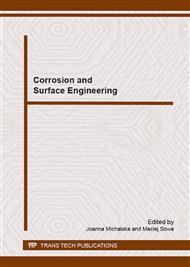p.507
p.511
p.515
p.519
p.523
p.527
p.531
p.537
p.541
Corrosion Resistance of Hip Endoprosthesis Cups in the Initial State and after Implantation
Abstract:
The aim of the paper was to compare physicochemical features of hip joint cups coated with hydroxyapatite in the initial state and after period of 36 months of implantation. The cups we produced from stainless steel Cr-Ni-Mo with increased content of azote dedicated to implants which chemical composition is compatible with recommended ISO 5832-9 standards. On the basis of obtained results it can be stated that hydroxyapatite resorption did not affect equally the entire surface of the cup. It was also stated that tested biomaterial of the cup was well wetted (hydrophilic). For all the tested samples prepared from cups in the initial state and cups after the implantation the presence of transpassivation potential Etr was stated, which proves not only good corrosion resistance but also biocompatibility of analyzed cups.
Info:
Periodical:
Pages:
523-526
Citation:
Online since:
January 2015
Authors:
Price:
Сopyright:
© 2015 Trans Tech Publications Ltd. All Rights Reserved
Share:
Citation:


